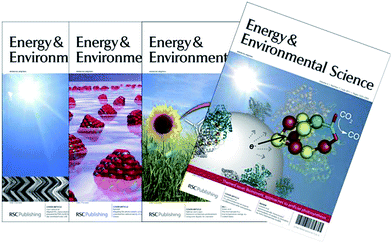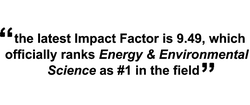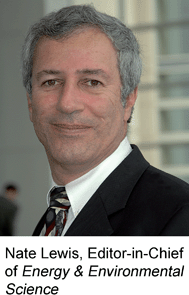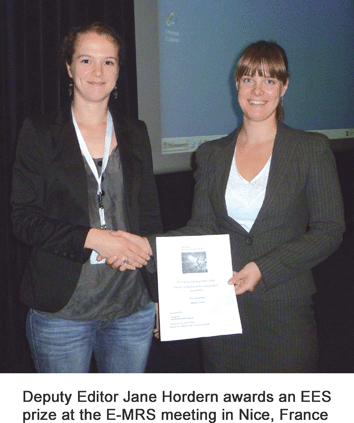Energy & Environmental Science: a community-spanning journal
Welcome to the first issue of Energy & Environmental Science in 2012. The journal has had another great year and we are looking forward to building on these achievements in the coming months and years. In this Editorial we would like to share some of our recent highlights with you, as well as looking forward to the exciting future of Energy & Environmental Science.
High impact research
Energy & Environmental Science recognises the complexity of issues and challenges relating to energy production and storage, and global environmental science. Since its launch in 2008, we have strived to make Energy & Environmental Science a truly community-spanning journal, and as such we particularly welcome work of an interdisciplinary nature across both the (bio)chemical and (bio)physical sciences and chemical engineering disciplines.The journal's scope is intentionally broad, covering all aspects of energy conversion and storage, alternative fuel technologies, and the science of environmental impacts and mitigation that are related with energy conversion processes, such as global atmospheric science, climate change, carbon capture, and environmental catalysis. The broad range of research which Energy & Environmental Science publishes is unique, and can be seen both in this current issue and in the list of most-read articles in 2011 shown in Table 1.
| Title | Author(s) | DOI |
|---|---|---|
| Review of solutions to global warming, air pollution, and energy security | Mark Z. Jacobson | 10.1039/b809990c |
| Graphene based new energy materials | Yiqing Sun, Qiong Wu and Gaoquan Shi | 10.1039/c0ee00683a |
| Organic tandem solar cells: A review | Christoph J. Brabec et al. | 10.1039/b817952b |
| Low-platinum and platinum-free catalysts for the oxygen reduction reaction at fuel cell cathodes | Adina Morozan, Bruno Jousselme and Serge Palacin | 10.1039/c0ee00601g |
| Bulk nanostructured thermoelectric materials: current research and future prospects | A. J. Minnich, M. S. Dresselhaus, Z. F. Ren and G. Chen | 10.1039/b822664b |
| Recent developments in nanostructured anode materials for rechargeable lithium-ion batteries | Liwen Ji, Zhan Lin, Mataz Alcoutlabi and Xiangwu Zhang | 10.1039/c0ee00699h |
| Development and challenges of LiFePO4 cathode material for lithium-ion batteries | John B. Goodenough et al. | 10.1039/c0ee00029a |
| Carbon nanotubes for lithium ion batteries | Brian J. Landi et al. | 10.1039/b904116h |
| Graphene-based nanomaterials for energy storage | Martin Pumera | 10.1039/c0ee00295j |
| Highly active cobalt phosphate and borate based oxygen evolving catalysts operating in neutral and natural waters | Arthur J. Esswein, Yogesh Surendranath, Steven Y. Reece and Daniel G. Nocera | 10.1039/c0ee00518e |
This year it was announced that the journal’s latest (2010) Impact Factor is 9.49, which officially ranks Energy & Environmental Science as #1 of all 192 journals in the field. This has been coupled with impressive growth for the journal, which can be seen in Fig. 1. These are great results for the journal, however we remain aware that it is important we continue to attract and publish only the highest quality research, and the Editorial Office is working hard to ensure Energy & Environmental Science remains the best home for high impact research.
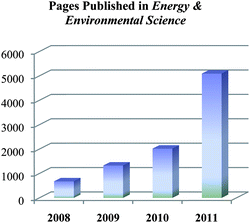 | ||
| Fig. 1 Energy & Environmental Science's impressive growth. | ||
An international profile
Energy & Environmental Science is supported by world-class international Editorial and Advisory Boards, led by Editor-in-Chief Professor Nathan Lewis. This year we were delighted to welcome a number of new members to the Energy & Environmental Science Advisory Board: Rodney Ruoff (UT Austin, USA) whose research includes the study of graphene, supercapacitors and materials for energy conversion and storage; Yang Shao-Horn (MIT, USA), who specialises in materials for electrochemical energy conversion and storage; Emilio Palomares (ICIQ, Spain) an expert in molecular photovoltaic devices; Chang-jun Liu (Tianjin, China) whose research covers catalysis and the utilization of greenhouse gases; and Markus Antonietti (Max Planck Institute of Colloids and Interfaces) whose research interests include energy materials and artificial photosynthesis. We welcome them all to the Board and look forward to working with them over the coming months and years. We also wish to thank our retiring Board members for their support of the journal.
In April 2011, Energy & Environmental Science co-organised the 1stInternational Conference on Clean Energy Science, which was held in Dalian, China. This high-profile international event had over 300 registrants and 65 speakers including Energy & Environmental Science Advisory Board member Kazunari Domen, as well as Peidong Yang, Can Li, James Durrant, Jaephil Cho and Changming Li. This exciting meeting was chaired by Advisory Board member Professor Xinhe Bao—we thank him for helping to coordinate such a successful meeting.
Energy & Environmental Science continues to support the scientific community by sponsoring a variety of international meetings through awarding poster prizes to some of the best up-and-coming new scientists. In 2011, we supported a range of conferences covering areas such as photovoltaics, solar fuels, artificial photosynthesis and CO2 utilization. Further sponsorship is planned over the next year, so if you have any suggestions of conferences where we could offer Energy & Environmental Science prizes please let us know at ees@rsc.org.
We will be attending more conferences throughout this year to ensure we are always aware of the latest cutting-edge research. So if we are at a conference you're attending please do come and say hello—we always welcome feedback from our authors, readers and referees.
High visibility
The Editorial Office continues to work hard to make sure the work published in Energy & Environmental Science has the highest visibility possible. The journal has a very broad readership appealing to chemical scientists, engineers, energy researchers, bio-scientists and environmental scientists from across academia, industry and government. To promote our content further, as well as our EESblog, we also have a dedicated Facebook page http://www.facebook.com/RSCEES and Twitter feed to highlight the latest high-quality research and news from the journal. We encourage you to sign-up and follow us today http://twitter.com/#!/ees_journal.Our Press Office also promotes Energy & Environmental Science articles to the wider scientific press, meaning work from the journal has featured in leading international scientific magazines, such as New Scientist, C&EN, Science and The Engineer, as well as newspapers including The Times and The Guardian. Articles featured include a life cycle analysis of algae-derived biodiesel by David A. King, Oliver Inderwildi and co-workers (DOI: 10.1039/C1EE01791H) and a Communication by Philipp Adelhelm and colleagues on sodium-ion batteries (DOI: 10.1039/c1ee01744f).
Going forward
We are committed to ensuring Energy & Environmental Science remains the #1 journal in its field, and we want to thank everyone in the scientific community who has contributed to this achievement; our authors, Board members, readers and referees—your dedication and support are invaluable to the success of the journal.We always welcome your comments and suggestions; so please contact us at ees@rsc.org.
With our best wishes for the New Year,
Jane Hordern
Deputy Editor,
Philip Earis
Editor, Energy & Environmental Science
ees-rsc@rsc.org
RSC Publishing growth and successes
Journals from RSC Publishing are delivering impressive results on impact factors, growth in quality content and international visibility and influence. The 2010 Journal Citation Reports® proved that our quality is better than ever, and that is thanks to our authors and referees. Of the top 20 journals in the multidisciplinary chemistry category, 25% are from RSC Publishing. Plus 83% of our journals listed in this year's report have an IF above 3.The number of articles published in our journals has almost doubled in just two years—and our share of the total has also nearly doubled in that time. More titles have recently joined our portfolio: RSC Advances and Catalysis Science & Technology. And Chemical Science received the ALPSP Award for Best New Journal 2011.
So more and more authors—from 70+ countries in 2011—are trusting us to ensure their research is communicated to the global community. Our Editorial and Advisory Boards are international, and our publishing operation is supported by offices in USA, China, India and Japan. Plus our content is downloaded by growing numbers of readers in virtually every country in the world.
These facts demonstrate that RSC journals are increasingly valued as a key resource for the very best research. www.rsc.org/journals
Books delivering the latest research advances, information, opinions and perspectives in modern science, confirm our reputation as one of the fastest and most dynamic publishers in the world.
In an age where content is key, we understand the importance of your online chemical science resource. The RSC eBook Collection now holds more than 1000 books, equating to over 25![[thin space (1/6-em)]](https://www.rsc.org/images/entities/char_2009.gif) 000 chapters, and spanning more than 40 years. The publication of our 1000th eBook in 2011 was a celebratory milestone.
000 chapters, and spanning more than 40 years. The publication of our 1000th eBook in 2011 was a celebratory milestone.
We continue to provide expert, interdisciplinary chemical science books: over 100 new print titles are planned for 2012 alongside the launch of several new series including:
• Food and Nutritional Components in Focus
• New Developments in Mass Spectrometry
• New Developments in NMR
• RSC Smart Materials
Our ability to deliver fast, accurate information to our customers was rewarded by the BIC Basic Award, an accolade held by few publishers. www.rsc.org/books
RSC Publishing platform
Access one million journal articles and book chapters in one simple integrated search.The RSC publishing platform provides the most valued interface and features that connect you with the highest quality scientific research. With one single search box, students, academics, researchers, scientists and professionals can easily access our books, journals and databases. www.rsc.org/platform
To access content on the go, download our RSC Mobile app for your electronic device.
Free online access
Free online access is available to all our newest journals, and much more - all you need to do is register for an RSC Publishing Personal Account. Once logged in, you will be able to access all our free content including:• All content of our newest journals for the first two volumes
• Any articles that are part of a special free access promotion (e.g. ‘hot’ papers, web theme issues, etc)
• A sample chapter from each book in the RSC eBook Collection
With your username and password you can access free content any time, any place—all you need is internet access. You can also save searches and favourite articles. Register now at www.rsc.org/personalregistration
If your institution/organisation is a current customer or on a free trial with IP registered addresses, you will be able to access all free content automatically, if authenticated. To request free access for your institution/organisation, go to www.rsc.org/freeaccess.
ChemSpider: the free chemical database
www.chemspider.com gives you the most comprehensive view of freely available chemical data from a single online search.Search: over 26 million structures from 400+ sources
Discover: related information from RSC publications, Wikipedia, Google Scholar & PubMed
Share: add and curate data
Access ChemSpider anytime, anyplace, anywhere with the free ChemSpider mobile app, www.rsc.org/ChemSpidermobile
RSC Conferences and events 2012
The RSC organises a broad range of conferences and events to promote the advancement of the chemical sciences. Please visit the website for the most up to date listing: www.rsc.org/eventsThe major scientific meetings planned for 2012 include:
| Challenges in Inorganic and Materials Chemistry (ISACS8) |
| 19–22 July 2012, Toronto, Canada www.rsc.org/isacs8 |
| Inorganic Photophysics and Photochemistry—Fundamentals and Applications (Dalton Discussion 13) |
| 10–12 September 2012, Sheffield, UK www.rsc.org/DD13 |
| This journal is © The Royal Society of Chemistry 2012 |

